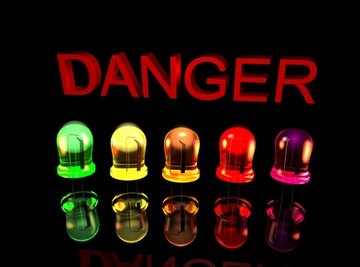
LEDs, an acronym for light emitting diodes, are tiny lights often no bigger than a small button. They are most often found on electronic devices. They are often used to indicate that the power is on. LEDs have also become popular as holiday ornaments. People string together scores of multicolored LED lights together to light up Christmas trees and to add a decorative flare to furniture and rooms. Wiring LEDs together is not complex, and that’s because they only have two leads. However, you must perform a few calculations to determine the right power supply voltage level.
Wire the LEDs
Determine the LED forward diode voltage. Look on the LED data specification sheet from the manufacturer. For this example, you might find "2.0 volts" listed on the data spec sheet.
Determine the voltage setting of the power supply. Multiply the number of LEDs by the diode forward voltage. For 50 LEDs and a turn-on voltage of 2.0 volts, the power supply voltage needed is 100 volts, because 50 multiplied by 2.0 equals 100.
Determine the amount of current needed. For a series connection of LEDs, the current needed is equal to the LEDs' diode forward current specification. This specification is found on the data sheet. For this example, the forward current specification is 40 milliamperes, which translates to "0.04 amps" for your calculation.
Calculate the value of the current limiting resistor. Divide the voltage supply level calculated by the forward current specification to determine the value of the current limiting resistor. In this case, it is 2,500 ohms, since 100 volts divided by 0.04 is 2,500. Note the resistance value in ohms is equal to volts divided by current in amps.
Turn your power supply is off. Wire the LEDs in series with the power supply and resistor. An in-series connection means to connect several two-leaded components, such as the LED, so that each lead of one component is connected to another lead of another component.
Make the in-series connection of 50 LEDs with the power supply and a resistor. Connect the left lead of the resistor to the positive terminal of the battery. Connect the right lead of the resistor to the left lead (the anode) of the first LED. Next, connect the right lead (the cathode) of the first LED to the left lead (the anode) of the second LED. Continue to connect the LEDs in this fashion until you reach the 50th LED. Connect the right lead (the cathode) of the 50th LED to the negative terminal of the power supply. Your 50 LEDs are now connected in series with the power supply and the resistor.
Apply Power to Circuit
- Power supply
- 50 LEDs
- Alligator clips
- Resistor
Check the manufacturer's LED data sheet for the marking that distinguishes the LED's anode and the LED's cathode. The cathode, also known as the positive LED lead, is usually the shorter of the two leads.
If your LEDs do not light, check to see if the anode and cathodes are connected correctly.
LED lead ratings and specifications are approximate. You may not need the actual voltage level calculated for the power supply. You may need a slightly higher or lower voltage for all your LEDs to light.
Study all and any electronic safety precautions. Improper electronic procedures can cause serious injuries. High electric currents can cause serious injury or death. Wear properly insulated shoes.
Review your power supply manual. Read its safety and operating instructions.
Set the power supply to its lowest voltage level (zero volts). For this example, also set the current supply limiting level to 40 milliamperes, the forward current specification of the diode.
Turn on the power supply. Slowly, turn up the power supply to 100 volts. Look at the LED string as you turn up your power supply’s voltage level. Stop increasing the voltage when you notice that the lights do not shine any brighter for an increase in voltage.
Turn off your power supply.
Things You'll Need
Tips
Warnings
References
Tips
- Check the manufacturer's LED data sheet for the marking that distinguishes the LED's anode and the LED's cathode. The cathode, also known as the positive LED lead, is usually the shorter of the two leads.
- If your LEDs do not light, check to see if the anode and cathodes are connected correctly.
- LED lead ratings and specifications are approximate. You may not need the actual voltage level calculated for the power supply. You may need a slightly higher or lower voltage for all your LEDs to light.
Warnings
- Study all and any electronic safety precautions. Improper electronic procedures can cause serious injuries. High electric currents can cause serious injury or death. Wear properly insulated shoes.
About the Author
Mark Stansberry has been a technical and business writer over for 15 years. He has been published in leading technical and business publications such as "Red Herring," "EDN" and "BCC Research." His present writing focus is on computer applications programming, graphic design automation, 3D linear perspective and fractal technology. Stansberry has a Bachelor of Science in electrical engineering from San Jose State University.
Photo Credits
led colorati image by claudio from Fotolia.com
